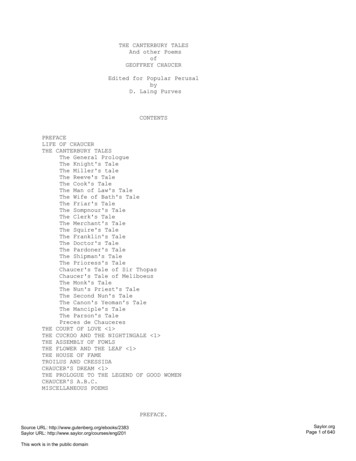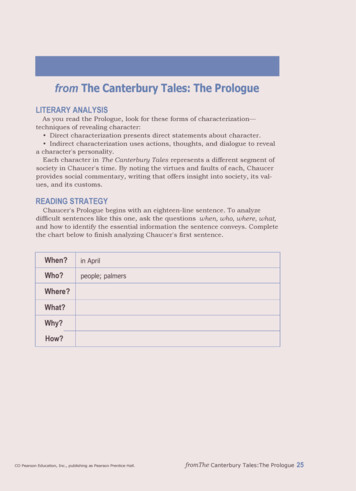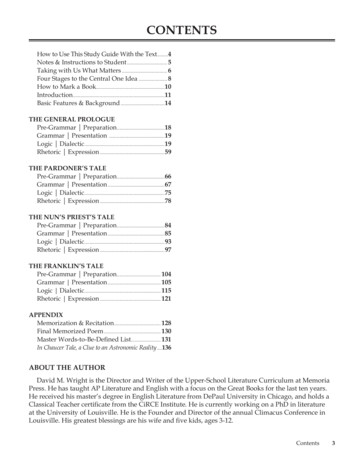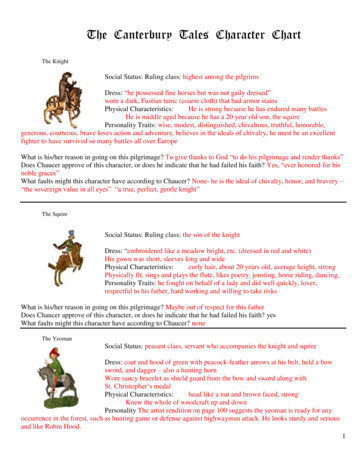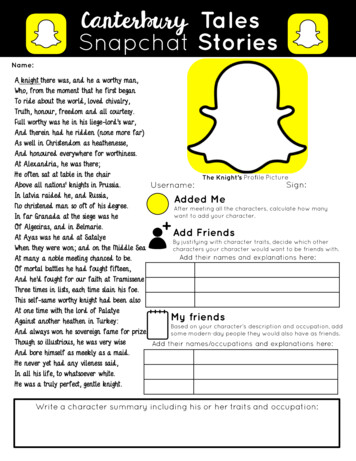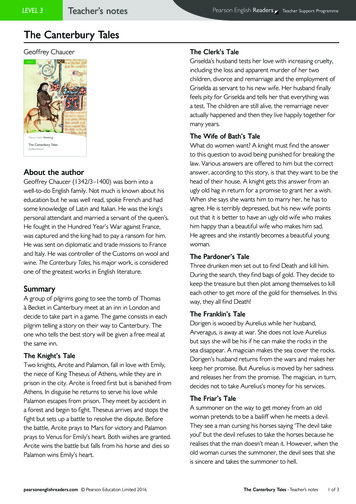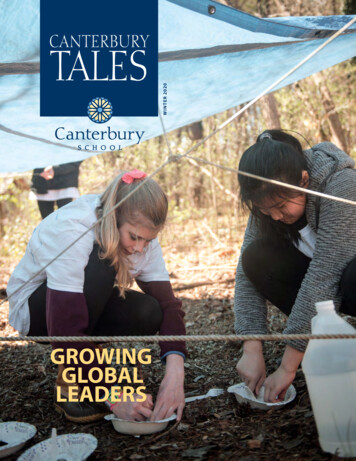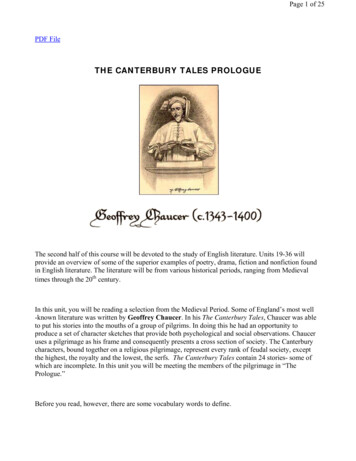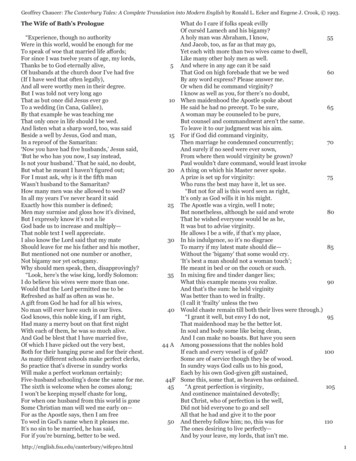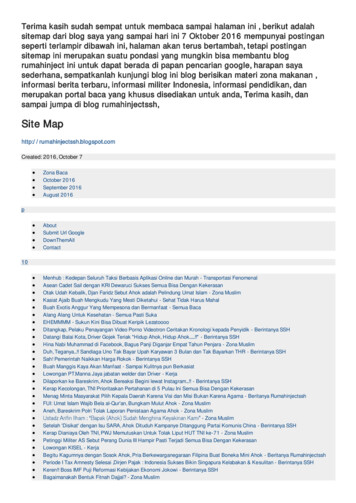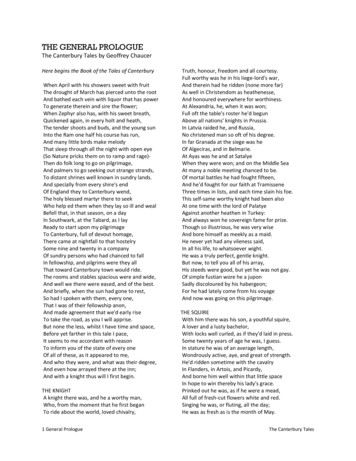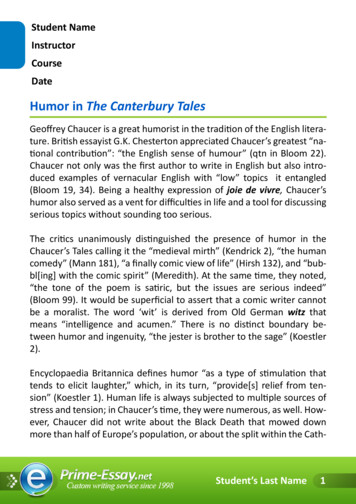
Transcription
Student NameInstructorCourseDateHumor in The Canterbury TalesGeoffrey Chaucer is a great humorist in the tradition of the English literature. British essayist G.K. Chesterton appreciated Chaucer’s greatest “national contribution”: “the English sense of humour” (qtn in Bloom 22).Chaucer not only was the first author to write in English but also introduced examples of vernacular English with “low” topics it entangled(Bloom 19, 34). Being a healthy expression of joie de vivre, Chaucer’shumor also served as a vent for difficulties in life and a tool for discussingserious topics without sounding too serious.The critics unanimously distinguished the presence of humor in theChaucer’s Tales calling it the “medieval mirth” (Kendrick 2), “the humancomedy” (Mann 181), “a finally comic view of life” (Hirsh 132), and “bubbl[ing] with the comic spirit” (Meredith). At the same time, they noted,“the tone of the poem is satiric, but the issues are serious indeed”(Bloom 99). It would be superficial to assert that a comic writer cannotbe a moralist. The word ‘wit’ is derived from Old German witz thatmeans “intelligence and acumen.” There is no distinct boundary between humor and ingenuity, “the jester is brother to the sage” (Koestler2).Encyclopaedia Britannica defines humor “as a type of stimulation thattends to elicit laughter,” which, in its turn, “provide[s] relief from tension” (Koestler 1). Human life is always subjected to multiple sources ofstress and tension; in Chaucer’s time, they were numerous, as well. However, Chaucer did not write about the Black Death that mowed downmore than half of Europe’s population, or about the split within the Cath-Student’s Last Name1
olic Church, or about other social, political, and economic problems inEngland of the fourteenth century. In The Canterbury Tales, Chaucerchose to depict the “whole English nation” as he knew it. All his pilgrimsdiffer from each other “not only in their inclinations but in their veryphysiognomies and persons Even the ribaldry of the low characters isdifferent: the Reeve, the Miller, and the Cook are distinguished fromeach other as much as the mincing Lady Prioress and the broadspeaking,gap-toothed Wife of Bath” (Bloom 20). By laughing at social classes, theauthor inflicts a kind of “corrective punishment” (Koestler 2). Accordingto Bergson, “in laughter we always find an unavowed intention to humiliate and consequently to correct our neighbour” (qtd. in Koestler 2).Ruggiers writes about two types of comic tales in Chaucer’s writing. Thecharacters of the first type – Miller, Reeve, Merchant, and Shipman – areyoung and smart, and they outwit the old and dull people in sexual conquests. The other half of the tales – the Friar, Summoner, Pardoner, andCanon’s Yeoman – are “nonsexual tales, comedies without lightheartedhumor; these are, more frankly, unmasking” (75). In these “wry comedies” of the second type, Chaucer aligns characters according to religiously defined norms: clericals should be pious and moral. With no typical comic tokens such as obscene actions, swearing, or practical jokes,the author operates with satire and dry irony only. In the Pardoner’s Tale,the moral is that greed is the root of all evil. The Pardoner is shown as ahypocrite who acts against what he preaches. Among his sins are greed,drinking, and gluttony; he deliberately deceives his parishioners in orderto get money from them. After the Pardoner has told about his hypocrisyand shared the tale, he returns to his usual mode of cajoling money outof people's pockets. Ruggiers states that a poet can expose villains andwrite “comedies about damnation” demonstrating that “comedy doesnot exclude suffering; it makes capital of it but uses it for its own endsand with the right tone and attitude” (76).In The Canterbury Tales, Chaucer used all possible genres, such as “epic,romance, fabliau, saint’s life, exemplum, sermon, mirror of princes, peni-Student’s Last Name2
tential treatise, tragedy, animal fable, Breton lay, confessional autobiography, Marian miracle—all these and more” (Bloom 98). One of the popular genres in the Middle Ages literature was satire on social classes – ‘estates’. In the medieval society, ‘estate’ implied person’s occupation andstatus.A perfect example of the estate satire is the General Prologue of TheCanterbury Tales that includes humorous portraits of almost each class.The characters are distorted deliberately. By exaggeration, the authormakes the characteristic features more prominent; by simplifying, inturn, he takes away everything that is irrelevant for his task. By juxtaposing the customary notions and satiric caricatures, in the reader’s mind,“[the reader] is made to recognize familiar features in the absurd and absurdity in the familiar. Without this double vision the satire would be humourless” (Koestler 3). For example, the clergy was regularly mentionedin the estate satire (Mann 17). Monks were expected to live modestly,and friars were the members of a Catholic religious order sworn to live inpoverty on charitable donations. Naturally, it is funny to see the gluttonous prelate, “He was not pale as some poor wasted ghost./ A fat swanloved he best of any roast” (Chaucer lines 205-206), and Friar greedy formoney, “Therefore, instead of weeping and of prayer,/ Men should givesilver to poor friars all bare”(231-232). Doctors should cure people anytime and anywhere, so it is quite shocking to see the Physician so interested in money, “For gold in physic is a fine cordial, / And therefore lovedhe gold exceeding all” (15).Subtle humor and irony are discernible in the physical descriptions of thepilgrims. The young Squire is handsome and ardent and “with locks as ifthey were pressed” (83). The Prioress is courtly, dainty, and quite; andher exquisite taste and manners are underscored by her speakingmanner: “And well she sang a service, with a fine / Intoning through hernose, as was seemly” (125). The Wife of Bath has “set widely”“gap-teeth” (478), and the Miller’s prominent feature was his nose with“a wart on which there stood a tuft of hair / Red as the bristles in an oldStudent’s Last Name3
sow’s ear” (571-572).Explicitly comic is the fabliaux genre. Before Chaucer, the fabliaux wereFrench comic tales in verse, simple in style and message. “Greed, hypocrisy, and pride are invariably punished, but so too are old age, mereslow-wittedness, and, most frequently, the presumption of a husband,especially an old one, who attempts to guard his wife's chastity” (“TheFabliaux”). Often the fabliaux were scatological or obscene and involvedpractical jokes and beatings. Within The Canterbury Tales, the fabliauxgroup includes the tales of Miller, Reeve, Shipman, Summoner, and Merchant. Kolve asserts that, despite being “coarsely obscene” and“verg[ing] upon blasphemy,” “Chaucer manages to create a narrativethat is not only funny but also oddly innocent and imaginatively gay”(79).The veil of humor enables Chaucer to say whatever he wants. Laughingcan justify any intentions, and any use of words as “this is play.” He intensifies that possibility by, for example, depicting the Miller as a personwho has drunk too much and is not responsible for his words, “Blame iton ale of Southwark, so I pray” (Chaucer 32). Thirty lines down, the narrator makes a similar apology again and asks his readers to blame theMiller if something is “amiss” (73). Thus, the Miller’s Tale received adouble permissiveness.Being quite realistic at the first sight, the frame of fabliaux implies thatreal people cannot be so gullible or so inventive and cunning (“The Fabliaux”). “The situations of medieval fabliaux were meant to seem artificial,not real” (Kendrick 61). The poetical form of the fabliaux amplifies theunderstanding that it deals with fictional events and, thus, it “meant tofree Chaucer’s art from certain demands we elsewhere legitimatelymake upon it” (Ruggier 79). The fabliau plots are short; they usuallyremind jokes; therefore, people are eager to laugh and not to take themtoo seriously.Student’s Last Name4
The most vivid example of a fabliau in The Canterbury Tales is The Miller’s Tale that tells the story of the romance between Nicholas, an Oxfordclerk, and Alison, an 18-year old wife of the old carpenter John. A newaddition to the old story of a love triangle is Absolom, a parish clerk, whois also in love with Alison. Inherent to every fabliau, the practical jokehere is when at night the infatuated clerk climbs the window to kissAlison, and she sticks out her rear end. The joke gets intensified whenthe clerk storms away to return with a hot iron poker and when knockingagain receives a fart from Nicholas. The comic effect is produced by anunexpected turn of events and is finished by Absolom branding with thepoker Nicholas, who cries “water, water” (Chaucer 629). According toBrewer, obscenities are the oldest form of humor, and in the case of TheMiller’s Tale, “the articulation of the insult into a fantastic story turns itinto a classically comic structure” (88).The Miller’s Tale also mocks the courtly love by portraying Absolom as anaspiring Alison’s page who sings serenades, plays guitar and patientlycourts his lady. In response, he obtains only a “burning kiss” that, in itsturn, is also a parody. The repetition of kisses, and not on the lips, intensifies the funny side of the situation. In addition, the Miller’s Tale makesreferences to the Biblical story of Joseph and Mary: “For I will tell alegend and a life / Both of a carpenter and of his wife” (Chaucer 33-34).Biblical parody is interpreted by medievalists as “the imitation” in orderto “implicitly reaffirm Christian doctrine” (Kendrick 29).Along with the fabliaux, medieval Europe entertained itself with the double-entendre riddles (Smith 1). In that genre, people could use vernacular speech that was considered coarse and low within the ideology ofChristianity. Indeed, riddles were obscene and crude. Medieval fabliauxand double-entendre riddles shared similar vocabulary where wordsreferred to sexual intercourse and genitals and had euphemism from theeveryday sphere. For example, ‘head’ or ‘hard’ were euphemisms forpenis, ‘hole’ for vagina, ‘will’ referred to sexual desire, and ‘smock’ – tothe lifting of garments prior to the intercourse (Smith 9). In the Mer-Student’s Last Name5
chant’s Tale, the old and blind husband, January, has his eyesightrestored, and the first thing he sees is his wife, May, having sex withDamian. “Up to the tree his eyes he quickly cast, / And saw how Damianhis wife had dressed/ In such a way as cannot be expressed” (Chaucer1116-1118). When May begins to soothe January saying that a blind mancould not see anything true, the husband’s words become blunter, “Butby my father's soul, I thought to have seen / How Damian right over youdid lean / And that your smock was pulled up to his breast” (1149-1151).Kendrick attributes that Chaucer’s tendency to combine high and low tothe medieval habit to balance the serious with the playful. According toKendrick, humor was a mean to make life more bearable. After a pandemic of bubonic plague in the fourteenth century, a prolonged war between England and France, and difficult economic situation, peopleneeded solace, and fiction was one of such remedies.Fiction is a paradoxical structure, a means of having it both ways,of conforming and rebelling, submitting and mastering at thesame time, of being two or more. [ ] other fictions, which wemight call ironic or comic, focus on the satisfaction of individualdesires for power at the expense of public order or morality.(Kendrick 52)In The Canterbury Tales, Chaucer exhibited command of all genres of themedieval literature ranging from tragedy and religious lyric to parody, inwhich humor, juxtaposition, improvisation, and irony played the keyroles. In The Canterbury Tales, Chaucer used humor for the purpose ofboth entertainment and satire. Playfulness is intrinsic to Chaucer’s bestworks; however, it does not indicate a lack of seriousness.Student’s Last Name6
Works CitedBloom, Harold. Bloom’s Guides: Geoffrey Chaucer’s The Canterbury Tales. NewYork: Infobase Publishing, 2008. bookfi.org. Web. 20 Nov. 2013.Chaucer, Geoffrey. The Canterbury Tales. canterburytales.org. The Electronic Literature Foundation, n.d. Web. 20 Nov. 2013.Kendrick, Laura. Chaucerian Play: Comedy and Control in The Canterbury Tales.Berkeley: University of California Press, 1988. ark.cdlib.org. Web. 20 Nov. 2013.Koestler, Arthur. “Humour.” Encyclopaedia Britannica Online. Encyclopædia Britannica Inc., 2013. Web. 20 Nov. 2013.Kolve, V.A. “Chaucer’s Fabliaux.” Bloom’s Guides: Geoffrey Chaucer’s The Canterbury Tales. Ed. Harold Bloom. New York: Infobase Publishing, 2008. bookfi.org.Web. 20 Nov. 2013.Mann, Jill. Chaucer and Medieval Estates Satire. Cambridge: Cambridge UniversityPress, 1973. bookfi.org. Web. 20 Nov. 2013.Meredith, George. “An Essay on Comedy and the Uses of the Comic Spirit.” ProjectGutenberg. May 13, 2005. Web. 20 Nov. 2013.Ruggiers, Paul. “Chaucerian Comedy.” Bloom’s Guides: Geoffrey Chaucer’s TheCanterbury Tales. Ed. Harold Bloom. New York: Infobase Publishing, 2008. bookfi.org. Web. 20 Nov. 2013.“The Fabliaux.” The Geoffrey Chaucer Page. sites.fas.harvard.edu. Joseph Wittig,26 Apr. 2001. Web. 20 Nov. 2013.Smith, Jennifer. “From Swifan to Swyved: Contemplating the Evolution of MedievalDouble-Entendre Literature.” medievalists.net. 1 Feb. 1999. Web. 20 Nov. 2013.Student’s Last Name7
The most vivid example of a fabliau in The Canterbury Tales is The Mill-er’s Tale that tells the story of the romance between Nicholas, an Oxford clerk, and Alison, an 18-year old wife of the old carpenter John. A new addition to the old
